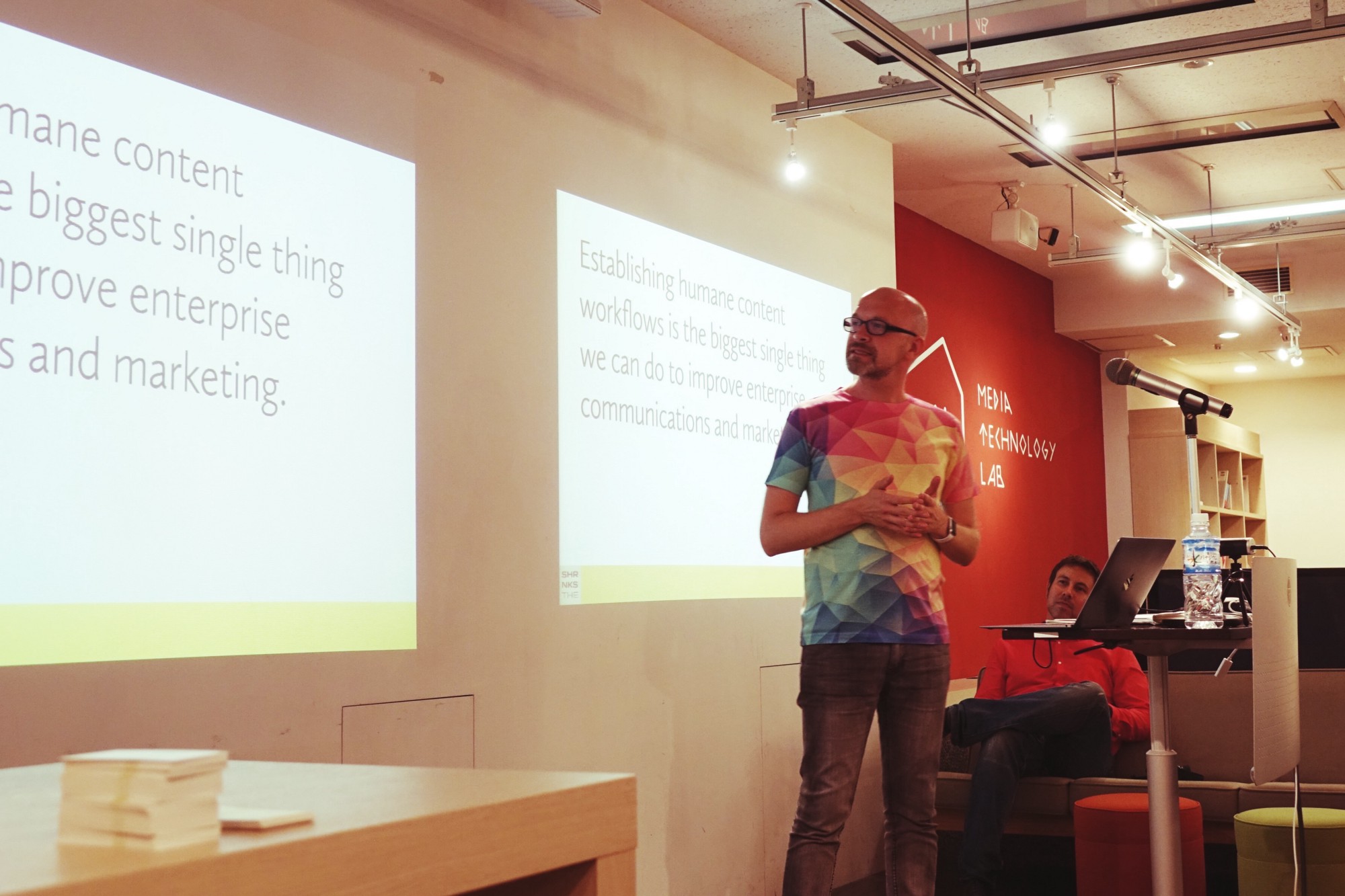
The Case for Humane Content Workflows
This is a synopsis of my talk at Tokyo Content Strategy Meetup x UX Sketch Tokyo on 15th August 2016 and a position paper emphasizing the need for a decidedly people-centric attitude in content strategy. To attend a future event, head over to the Events page.
TL;DR: Content is a proxy for human-to-human interaction. Projects fail mostly because inter- and intra-human interfaces break down. As content is the only tangible unit of expression available to connect with its employees, agencies and the market, we need a human-focused approach to content strategy. In this article, I lay out the basis to achieve this within daily business operations.
Hey Siri. Swipe right.
When we planned the event, [Tyler Harder] and I arrived at the event title seemingly by chance. “AI vs. Brains - The Future of Content Strategy” encapsulated one of the biggest issues that is discussed in the content strategy scene right now: The convergence of articifial and emotional intelligence. While Tyler proceeded to present his views of AI as the driving force behind current and coming changes to content strategy, I focused on the human, humane, emotional aspects.
People are trying, increasingly, to offload more and more of their brains into machines. We are trending towards becoming more algorithmic and more deterministic; less vague, less emotional and less aware of what we perceive as human shortcomings. At the same time, we are trying to program computers to become more human, paradoxically including some of those perceived shortcomings. Ask Siri to show you all gnocchi pics from 2013, and you’re standing right at the juncture of these trends: a computer program not yet human enough to engage in a conversation with a real human feeling insufficiently algorithmic to make himself understood.
More content is produced and consumed automatically: Websites publish massively split-tested clickbait headlines which the algorithms on Flipboard’s and Facebook’s servers skim before presenting to you what they think might be interesting.
This seems like the usual game of cat-and-mouse that we have come to know from disciplines such as search engine marketing; however most companies don’t realize that content is a proxy for human-to-human interaction, and a mediator for trust. Unless customers are replaced by AI, we need a much more focused approach on human factors in planning, creating and curating content.

About 3 years ago, I wrote in The Gnocchi Incident that the field of content strategy, while having contributed massively towards transforming the web into what it is today, is still lacking a much-needed focus on human factors. Here is an excerpt of the original Content Therapy Manifesto:
Content needs to match the speaker first and then the listener, because the listener can only trust the content if the speaker trusts himself. […] Thus, before any content strategy work can be really productive, each content producer […] needs to be the best he can be at a very personal level.
Since then, we have listened to an increasing number of people who came to understand that failed content-strategic efforts can often be traced back mainly to failed intra-company, intra-/inter-team and intra-personal communication, and it’s becoming clearer and clearer that establishing humane content workflows is the biggest single thing we can do to improve enterprise communications.
Content Strategy: Axioms
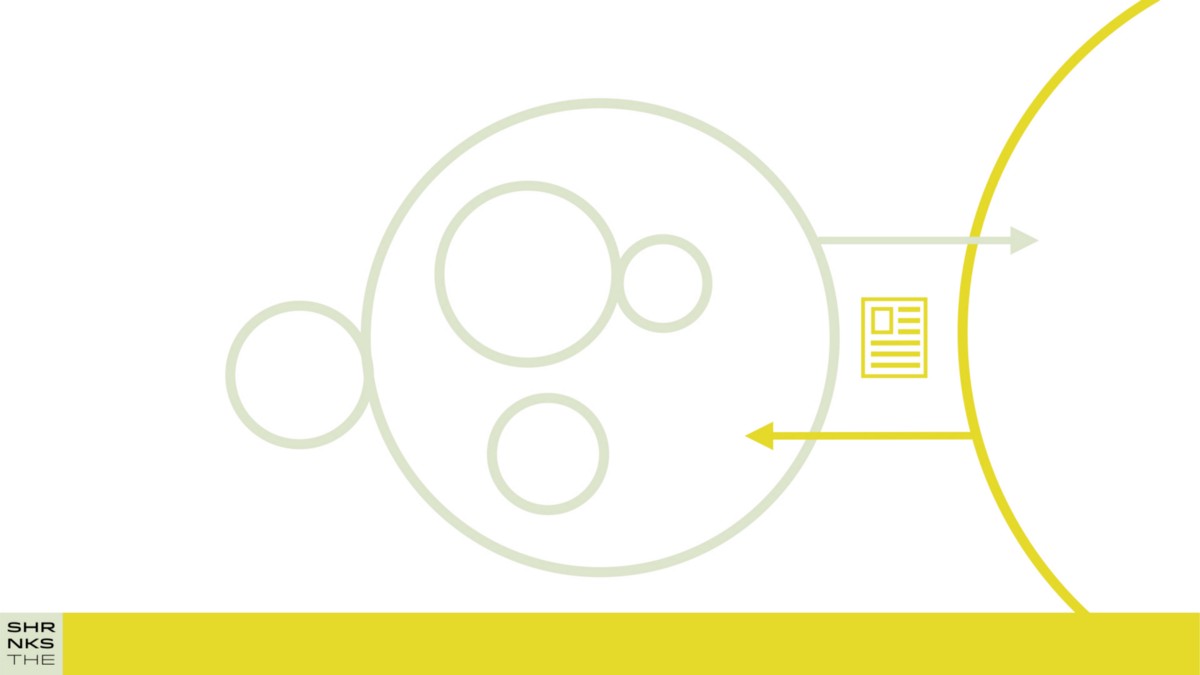
Some people don’t tire of complaining about the abundance of “content strategy” definitions. They are missing the point, however, because what matters are working definitions, not objecti-glorified general definitions that are basically worthless - especially in a field that is very much in flux. In our day-to-day business, this set of axioms has so far proven to work well:
- Content is a tangible asset for communication: transmitting ideas and generating action. This should come naturally for everyone whose definition of “content” predates the “content marketing” business that has sprung up in recent years. Business-wise, think of content as any incarnation of an idea.
- Content is a proxy for human-to-human interaction. Well, duh. If you could, and wanted to, talk to each and every client directly, you wouldn’t need all those brochures, drip e-mail campaigns and tweets. This axiom is a generalization of my principle that content is a mediator for trust. When direct human-to-human interaction is not feasible, content - in the form of sales brochures, internal training documents, help desk content, etc. - can stand in for a sales rep or trainer.
- Content must work both within an organization and outside its bounds. Considering as “content” only those artifacts created for communication with “the market” is short-sighted. Content within the organization (think training documents, help desk content, intranet posts) can be of the same, or even higher, importance.
- Content Strategy is the discipline of mapping business processes to a living, well-organized, purposeful system of content. I have worked as what my then-employer called “digital strategist,” and have been working as a “content strategist” since 2005ish, but in the end it’s all about business strategy. Content strategy is an integral part of a business’ strategy just because content is needed to mediate ideas and effect action.
Humane Content Workflows
Tools like Basecamp, Pivotal Tracker, or the all-seeing Slack have become normal parts of our life as content wranglers, and for quite some years now, we’ve had all the electronic and workflow tools we need. Of course, they are getting more and more refined, and the good ones help us let them get out of our way and focus on doing our best work.
But in a baffling number of businesses, small mom-and-pop operations and huge corporations alike, having a content workflow means that Bill calls Gladys on the phone to announce that in five minutes he’s going to send her an e-mail with SalesBroch_Widget-v2-NEW.docx and IMG_0893.bmp attached, cc’ing the whole team and the client, just in case.
As soon as you leave the 1% of behind-the-scenes high-tech companies, talking about ticket workflows earns you wide-eyed gazes, and asking which web apps your client is using to collaborate on their content calendars prompts the question what you’re talking about, followed by a helpless nod in the direction of the calendar hanging next to the water cooler.
You’ve created a content strategy for Bill’s Vegan Goldfish Food Emporium? Well, meet Bill and Gladys. Oh, and the guy in the corner who didn’t speak up once during your onboarding workshop: That’s Scott, Head of Sales, he basically runs the business and he don’t like none of that new-fangled internet stuff. Good luck introducing your IFTTT-enhanced notification auto-slackbotting content strategy.
Focusing on the human side of content strategy and its implementation is what our work at [The Content Shrinks] is all about. Here are some rules and strategies that, for us, have proven effective in achieving this:
1. Each piece of content needs a purpose and an effect that can be measured.
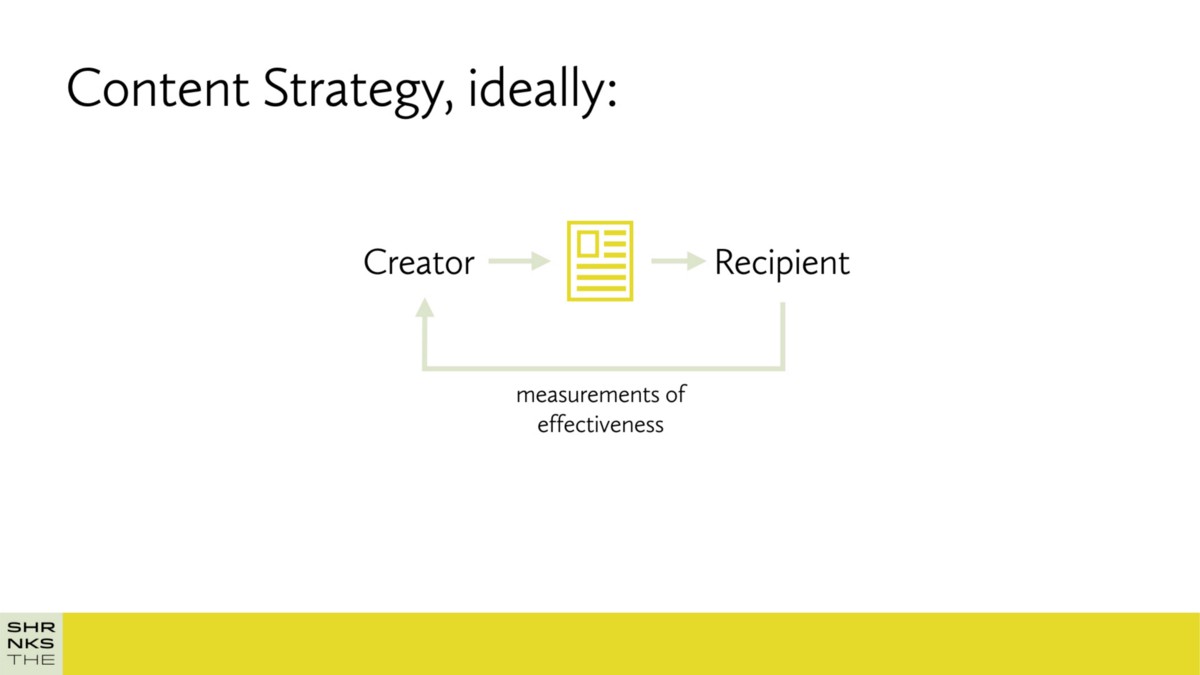
Measure or perish. No, really, there’s no point at all in creating goal-oriented content without putting in place measuring tools that go well beyond vanity metrics. Don’t think number of clicks or time spent, think sick days and EBIT.
This should come naturally, right? Of course you should create content only after you’ve determined whom you’re creating it for and what its desired effects are. We get lots of nodding heads when talking about this principle in workshops, but it turns out that in practice, this principle is violated nearly every day.
Take some time (and, yes, effort and money) to become clear about purpose and effect of content that you’re going to create and curate. Then, establish means of measurement to see if those effects are, in fact, reached-all of this before you start creating anything.
2. Leadership Alignment is an integral part of every content strategy.

A flock of birds is only a flock when viewed from the outside. From the birds’ point of view, each just sees his nearest neighbors and adapts to their flight path. What we perceive as higher-level order from the outside is the result of (probably) simple, local rules.
When your job is to create a productive content team, start by communicating the desired end result (the flock) in a top-down (or central-decentral) way so that what has been agreed upon as business strategy arrives, unadultered, at every level of your organization. Then, establish simple, local rules so that each team member knows what they are expected to do - and have enough wiggle room to move around on their own.
First, explain the why until everyone involved understands. Then, collaborate to establish the how.
3. While planning, start with the recipient; in operations, start with the author.

Pro tip: When planning, try visualizing your recipient sitting on the other side of your whiteboard; when writing, imagine him behind your computer screen. How does he react to what you’re writing right now? (Of course, this presupposes that you have an idea about whom you’re creating content for, so get this sorted out first.)
In planning, define (top-down) the intended effect of each piece of content and have only the recipient in mind. “Effect,” in most cases, means to nudge someone to do something, or to help them do something better than they could’ve done without your piece of content. As said above, never start creating content without having defined effect and means of measurement. If your client’s reply to the measurement question consists of vanity metrics such as “clicks per day,” help them clarify the relationship between those metrics and their business metrics. Can they backtrack their reasoning from sick days or EBIT to clicks per day?
When effects and measurement are well-documented and the time has come to actually create or curate content, focus on the people that do the work. Make sure that they know about the effect of the pieces of content they are tasked with creating. Make extra sure to align them with the overall strategy, and do go the extra to make really really sure that they are happy doing their job and have everything they need to be the best at what they do and who they are. Remember manifesto item no. 9:
In an ideal world, this is true for each and every person working on your content, regardless of him or her being an employee of your org or an external agency. In the real world however, friction in intra- and interpersonal workflows are real issues, so assist your teams to work well with each other, and coach your employees to get to grips with what is happening inside their heads.
4. To structure content, structure people first.
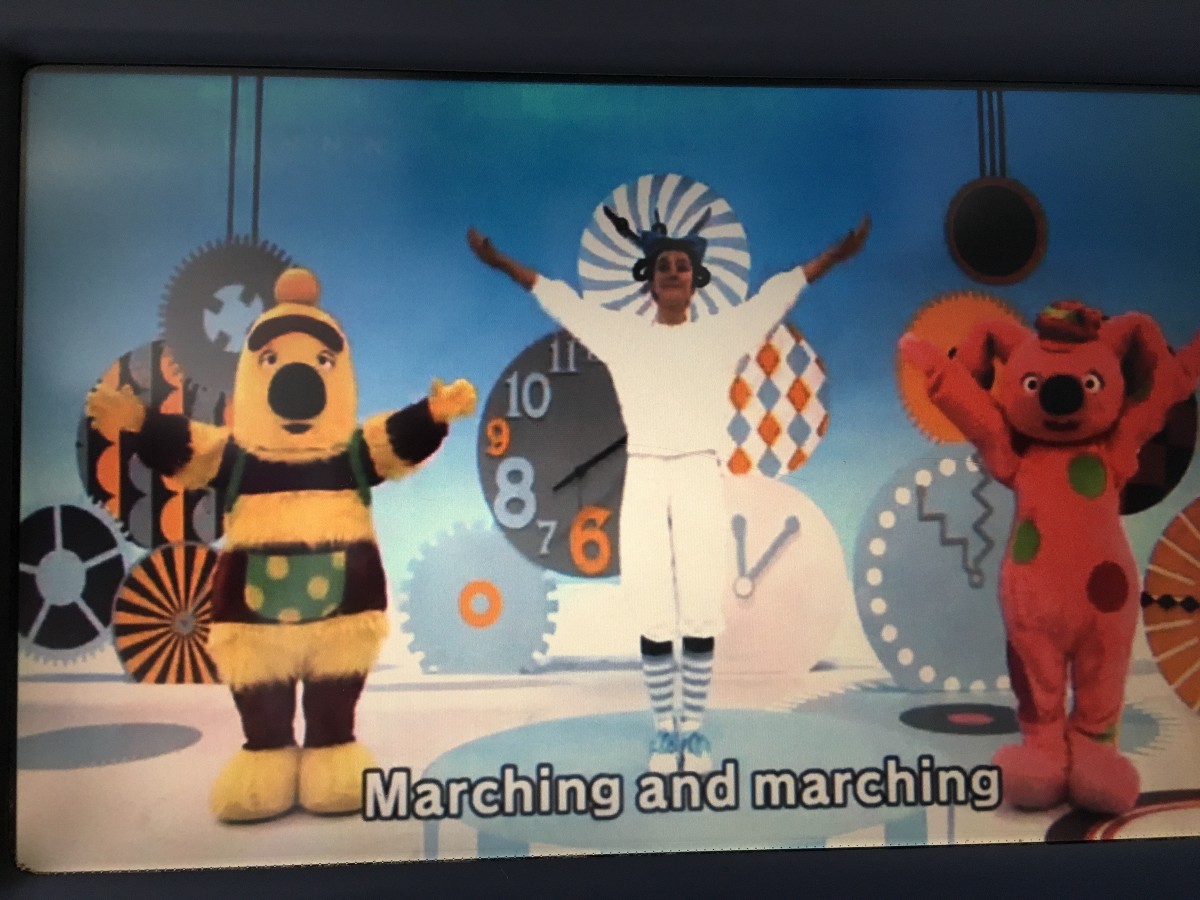
Silos, yadda yadda. Of course you’re going to run into problems - No, not “challenges.” Capital-p Problems. - if your marketing guys don’t talk to the sales guys. People are capricious, because, hey, people are people. Good on you if you notice that your departments are fighting each other; not good on either you or them if you introduce plans to break down silos.
Instead of breaking stuff down, help your guys and gals to open up: once the ball gets rolling, it’s surprisingly easy. If you’ve done №. 2 right, silo boundaries will vanish by themselves. They have been political-mental constructs all the time anyway, all too often propped up by corporate regulations whose atomic elements are departments - teams if you’re lucky - and not people.
So work the interfaces, because that’s where most problems arise. The company-market interface is the most obvious, but don’t forget the department-agency interfaces, those between teams, those between members of teams and those within each employee’s head. Inter-personal and intra-personal issues are among the major factors why projects fail, and although they are often not impossible to solve, they seem to be impossible to be talked about. I’ve had a psychotherapy practise for ten years so I do know that only a fraction of what is happening in our minds is visible - but on a behavioral level, it’s enough to achieve lasting change, even for non-psychotherapists. Be brave.
5. Plan for effects, not channels.

A client’s PR executive once told us that she didn’t want to use Twitter for the campaign and insisted on using Pinterest. Asked about the reasons behind her choice, she said that her 15-year-old daughter thinks that Twitter is not cool and thus Pinterest was the way to go-for a large-scale commercial real estate development.
**Think effect, not channel.**Whom should your content reach within and outside your organization? Whom should it touch along its way, and what are the effects that it should have with these people? Only when the purpose and intended effects of the content are clear and only when you know how to measure them, start planning the channels to reach your recipients. This will save you hours upon hours of planning meetings filled with vague but-we-could-use-Instagram-because-the-other-companies-have-lots-of-followers arguments.
Epilogue: Closing the gaps

I recently did a corporate change workshop for the marketing team of a largish industrial company. The firm’s decades old org structures have a hard time adapting to this new-fangled digital stuff, so there’s massive need to get them up to speed for the content-laden present and future.
In the afternoon, a group of employees from a different silo-uhm, sorry - team joined us. Apparently it had taken some effort to convince them to join; it seemed that I was the only one who realized their crucial role in the firm’s marketing ecosystem. I spent about half an hour aligning both teams, mostly by appealing to shared values; pointing out what each team could do to help the other in reaching common goals; breaking these abstract concepts down to concrete tasks; and some tricks I pulled out of my psychotherapist hat. After years of deadlock, people were beaming all over, and some time later I received news that those two teams are indeed working more closely together now.
Gaps, or silo boundaries, are as much inter-team constructs as they are intra-personal ones. Help each of your team members get their minds, brains, hearts in order, and let this personal momentum fan out into the realms of inter-personal, intra-team, inter-team and inter-department communications. Somewhere along the way, this bottom-up dynamic will meet with your top-down alignment efforts I’ve talked about before, and, rest assured, good stuff will happen.
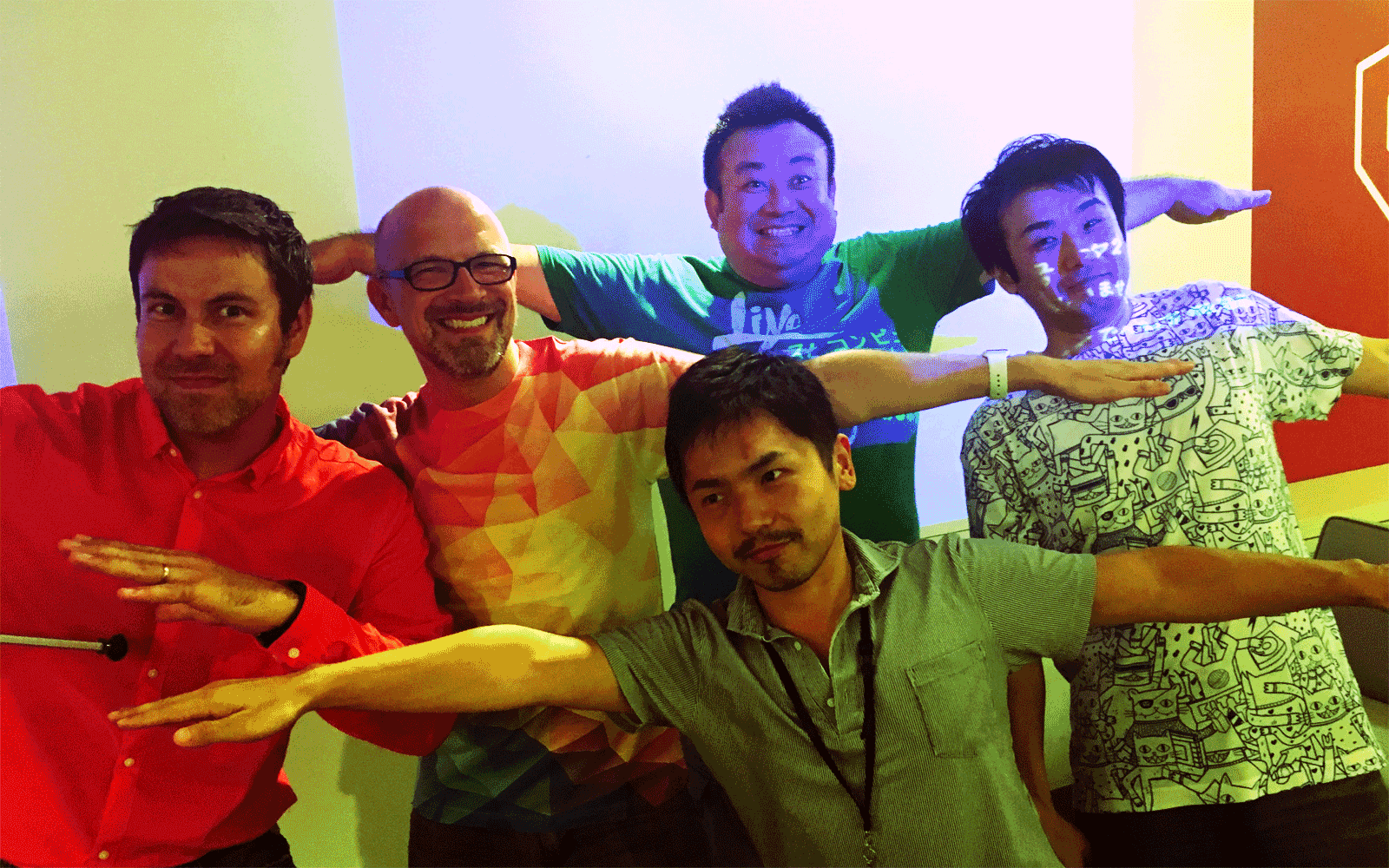
Thank you, Satoshi Kikuchi and Tetsuya Sekine for your assistance in promoting the event and deciphering izakaya menus; to Yasuhisa Hasegawa for your flawless Japanese translation of our talks; to Soya Iwasaki of L’Orem and Shin Matsukawa of Media Technology Lab for venue, beer, pizza and great vibes; to Tyler Harder, AI wizard and co-presenter of the evening; and Christian Gericke, Rahel Anne Bailie, Karen McGrane and John Allsop for helping me find the right doors to knock on. Without you, this event wouldn’t have been a hundredth of the success and fun it was. ありがとうございました! 🙇🏼
○ ○ ○
Seeking sponsors! Remembering the three participants of my first Tokyo Content Strategy Meetup in 2014, we were equally baffled and humbled by the huge visitor turnout at this event when there were 180 more sign-ups than our venue could handle. If you want to sponsor the next event in spring 2017, please write to hi@shrnks.co.